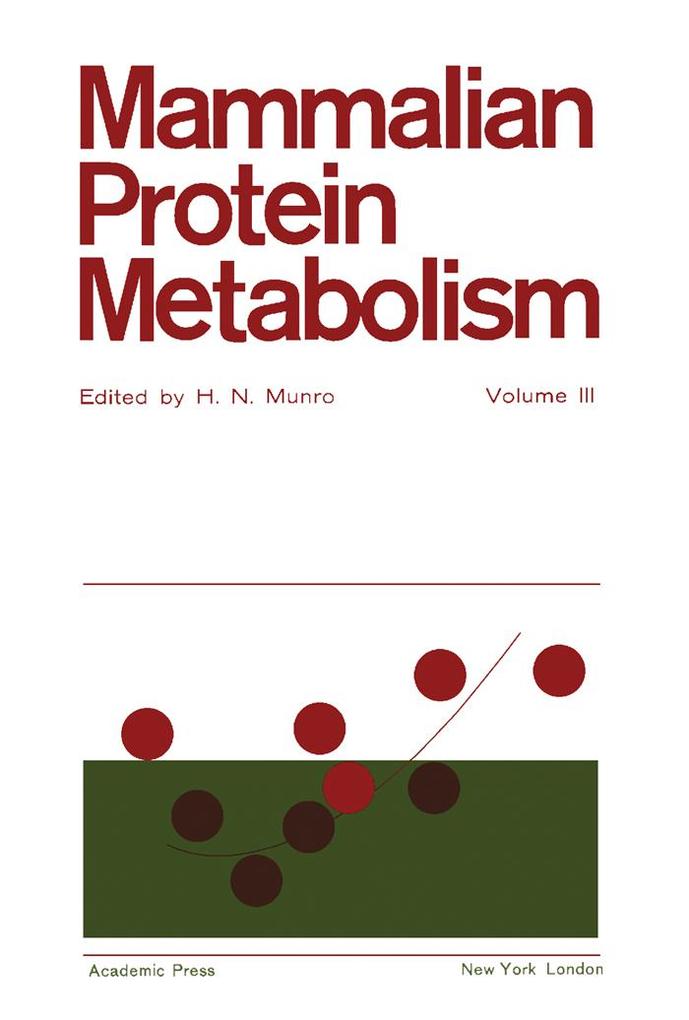Mammalian Protein Metabolism, Volume III, provides an overview of the state of knowledge on mammalian protein metabolism. It enlarges and adds depth to the picture of protein metabolism provided by Volumes I and II. The present volume covers two aspects of protein metabolism not specifically considered in the earlier parts of the treatise. First, there is a section of three chapters dealing with changes in protein metabolism during evolution and during growth and development. At its most fundamental level, this part deals in reality with an aspect of regulation of protein metabolism, since differences in metabolism between species and changes occurring during growth are both outward expressions of genetic control mechanisms that determine the form and characteristics of an animal. The other section in this volume is a survey of methods appropriate to the study of protein metabolism in mammals. This part of the work should prove of special interest to investigators who require a critical evaluation of the possibilities and limitations of methods applicable to intact animals.
Inhaltsverzeichnis
1;Front Cover;1 2;Mammalian Protein Metabolism;5 3;Copyright Page;6 4;Table of Contents;13 5;List of Contributors;7 6;Preface;9 7;Preface to Volumes I and II;11 8;Contents of Other Volumes;17 9;PART IV: Protein Metabolism during Evolution and Development of Mammals;21 9.1;An Introduction to Protein Metabolism during the Evolution and Development of Mammals;23 9.1.1;I. Introduction;23 9.1.2;II. Origin of Life;24 9.1.3;Ill. Evolution of Species;31 9.1.4;REFERENCES;38 9.2;CHAPTER 24. Evolution of Protein Molecules;41 9.2.1;I. Introduction;42 9.2.2;II. Evolutionary Changes in Protein Structure;60 9.2.3;.II. Functional Differentiation of Proteins as a Result of Evolutionary Divergence;106 9.2.4;IV. Taxonomic Serology in the Study of Evolution;114 9.2.5;V. Statistical Procedures and Computer Techniques;117 9.2.6;VI. Conclusion;145 9.2.7;REFERENCES;146 9.3;CHAPTER 25. Evolution of Protein Metabolism in Mammals;153 9.3.1;I. Introduction;153 9.3.2;II. Evolution of Protein Metabolism in Animals;154 9.3.3;III. Species and Individual Differences in the Protein Metabolism of Mammals;164 9.3.4;IV. Effect of Species Size on the Protein Metabolism of Mammals;170 9.3.5;V. Conclusions;195 9.3.6;ACKNOWLEDGMENT;196 9.3.7;REFERENCES;196 9.4;CHAPTER 26. Protein Metabolism during Growth and Development;203 9.4.1;I. Introduction;203 9.4.2;II. Rate of Growth: Continuous or Discontinuous?;205 9.4.3;III. Dynamic Aspects of Protein Metabolism during Development;209 9.4.4;IV. The Influence of Diet on Development;239 9.4.5;V. Restatement of the Problem;246 9.4.6;REFERENCES;247 10;PART V: Technical Aspects of the Study of Protein Metabolism;255 10.1;A General Survey of Techniques Used in Studying Protein Metabolism in Whole Animals and Intact Cells;257 10.1.1;I. Introduction;257 10.1.2;II. Use of Isotopes in the Study of Protein Metabolism;258 10.1.3;III. Methods for Studying Protein Metabolism in Whole Animals and Man;262 10.1.4;IV. Methods for Studying Protein Metabolism in Isolated Tissues and
Cells;271 10.1.5;V. Application of Cytochemical Techniques to Protein Metabolism;274 10.1.6;REFERENCES;279 10.2;CHAPTER 27. Application of Computers to the Study of Protein Metabolism;283 10.2.1;I. Introduction;284 10.2.2;II. General Description of Computers;286 10.2.3;III. Relevant Mathematical and Biological Backgrounds;295 10.2.4;IV. Compartmentation;299 10.2.5;V. Digital Simulation of Amino Acid Metabolism;304 10.2.6;VI. Protein Synthesis and Its Control Studied with Analog Computer Models;315 10.2.7;VII. Probable Future Developments;341 10.2.8;REFERENCES;342 10.3;CHAPTER 28. The Assessment of Protein Nutrition and Metabolism in the Whole Animal, with Special Reference to Man;345 10.3.1;I. Introduction;346 10.3.2;II. The Protein Content of the Whole Body and of Organs and Tissues;347 10.3.3;III. The Effect of Protein Depletion on the Distribution of Protein in Organs and Tissues;354 10.3.4;IV. Nitrogen Balance;361 10.3.5;V. The Value of Measurements on Blood and Urine for the Assessment of Protein Nutrition;367 10.3.6;VI. Measurement of Total Amino Acid or Nitrogen Turnover;380 10.3.7;VII. The Effect of Nutritional State on Plasma Albumin Turnover;399 10.3.8;VIII. General Conclusions;404 10.3.9;REFERENCES;405 10.4;CHAPTER 29. Methodology of Protein Evaluation;411 10.4.1;I. Introduction;411 10.4.2;II. Weight Gain Methods;412 10.4.3;III. Nitrogen Balance Methods;418 10.4.4;IV. Net Protein Utilization;419 10.4.5;V. Comparison of Nitrogen Utilization and Weight Gain Methods;420 10.4.6;VI. Chemical Scoring Methods;423 10.4.7;VII. Miscellaneous Methods;425 10.4.8;VIII. Availability of Amino Acids;426 10.4.9;IX. Supplementary Value of Proteins;429 10.4.10;X. Evaluation of Diets;431 10.4.11;XI. Significance of Amino Acid Requirements in Methods for Protein Evaluation;435 10.4.12;XII. Summary;436 10.4.13;ACKNOWLEDGMENT;437 10.4.14;REFERENCES;438 10.5;CHAPTER 30. Analysis of Tissues and Body Fluids for Nitrogenous Constituents;443 10.5.1;I. Introduction;444 10.5.2;II. Es
timation of Total Nitrogen;444 10.5.3;III. Estimation of Protein;458 10.5.4;IV. Measurement of Nucleic Acids in Tissues;485 10.5.5;V. Measurement of Tissue Phospholipid Nitrogen;503 10.5.6;VI. Measurement of Nitrogen-Containing Small Molecules;505 10.5.7;VII. General Aspects of Tissue Analysis for Nitrogenous Constituents;513 10.5.8;REFERENCES;529 11;Author Index;547 12;Subject Index;579













